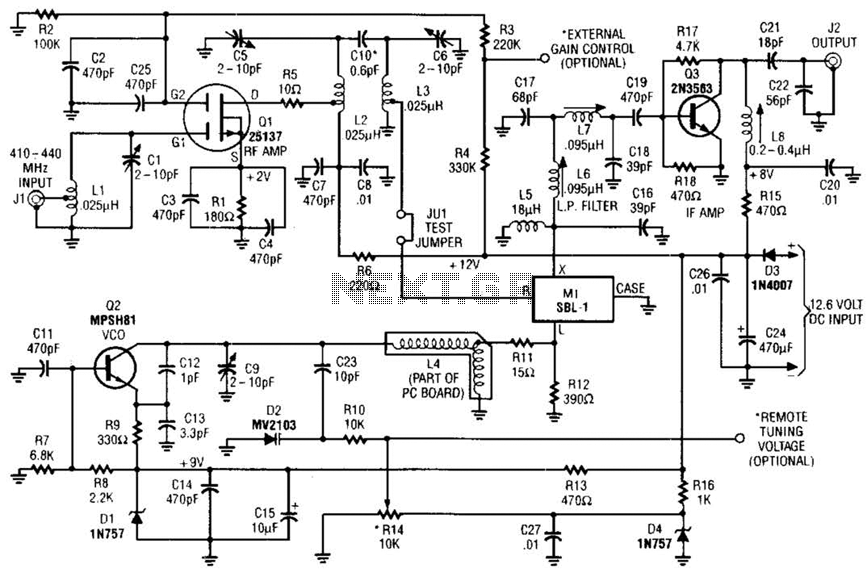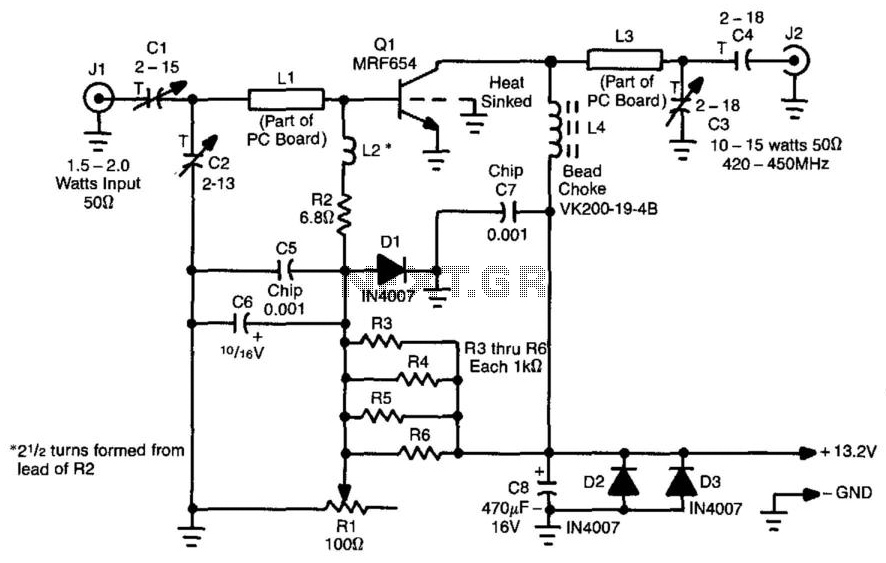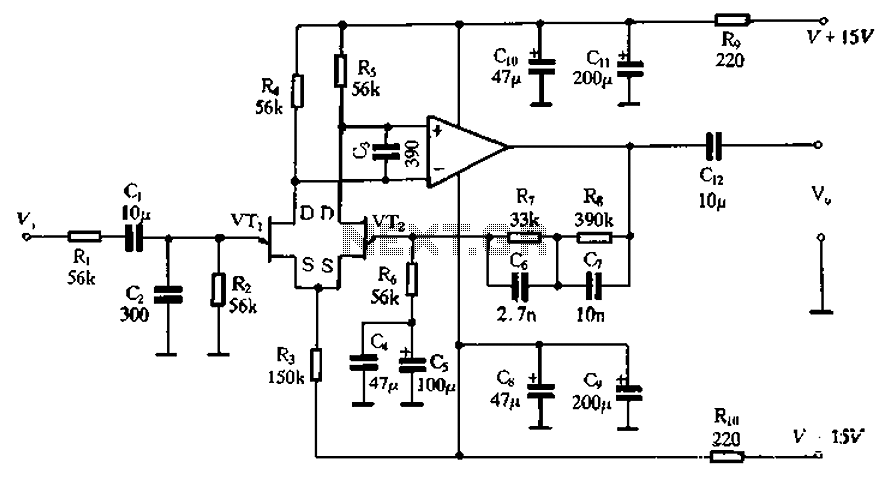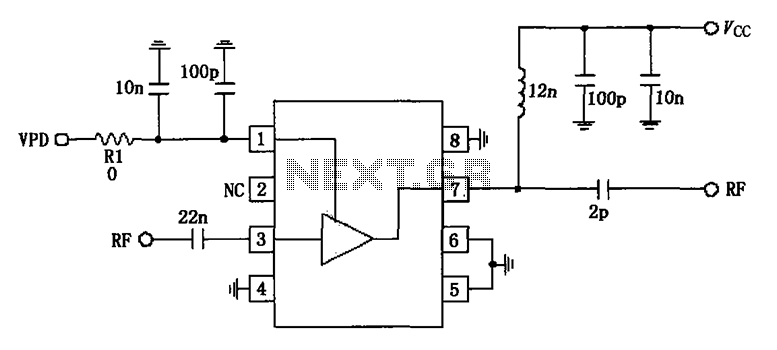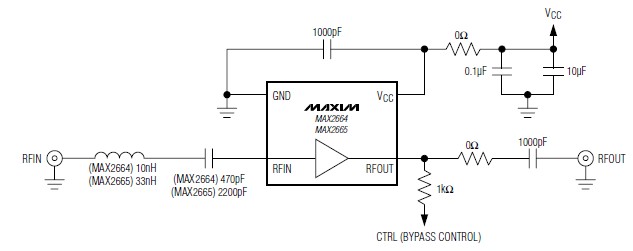
Low-Noise 420Mhz Atv Receiver/Converter
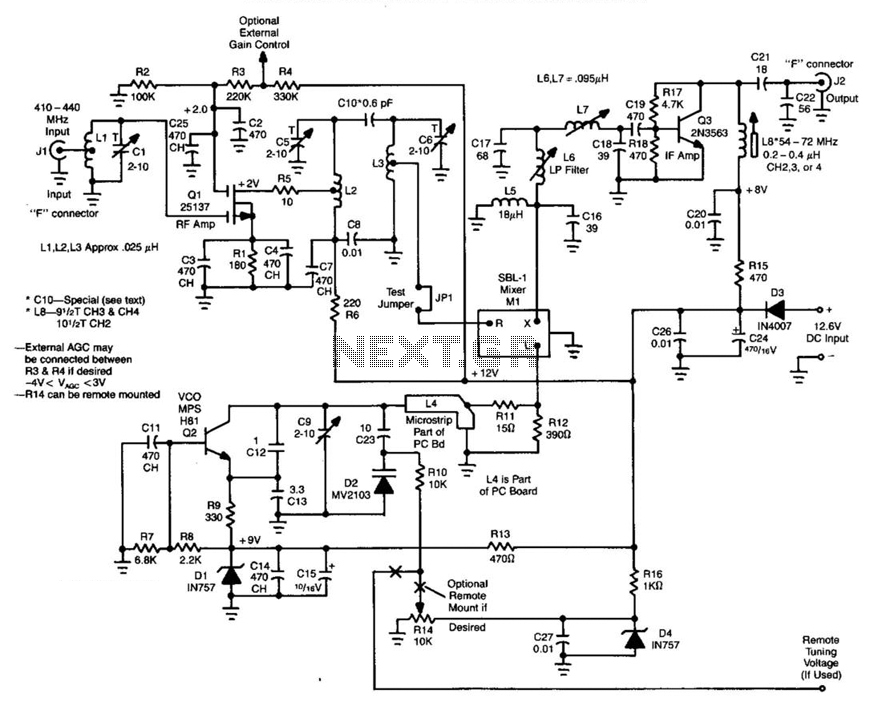
Ll, Ql, L2, and L3 form an RF amplifier stage that feeds Ml, a doubly balanced mixer. Q4 is a local oscillator stage operating in the 375-MHz range. Signals in the 420- to 450-MHz range from Ql are mixed in Ml and passed through filter L6/L7/C17, allowing only the 60- to 70-MHz (CH3/CH4) signals to pass. The IF signal is then sent to Q3, an IF amplifier. The overall gain is 25 dB, and the noise figure is less than 2 dB.
The circuit described consists of several critical components that work together to process radio frequency signals effectively. The RF amplifier stage, comprising inductors Ll, L2, L3, and transistor Ql, is designed to amplify the incoming RF signals before they are sent to the doubly balanced mixer, Ml. This mixer is crucial for converting the high-frequency RF signals into a lower intermediate frequency (IF) that can be more easily processed.
Q4 serves as the local oscillator, generating a stable frequency at 375 MHz. This frequency is mixed with the incoming RF signals, which range from 420 MHz to 450 MHz. The mixing process in Ml produces several frequency components, including the desired IF signals and unwanted spurious signals. To isolate the desired signals, a filter composed of inductors L6, L7, and capacitor C17 is employed. This filter is specifically designed to allow only the 60 MHz to 70 MHz signals, corresponding to channels CH3 and CH4, to pass through while attenuating other frequencies.
Once the desired IF signals are filtered, they are sent to Q3, which acts as the IF amplifier. This stage is critical for boosting the strength of the filtered signals to a usable level for further processing or demodulation. The overall gain of the circuit is specified at 25 dB, indicating a significant amplification of the signal. Additionally, the noise figure of less than 2 dB suggests that the circuit is designed to maintain a high signal-to-noise ratio, which is essential for achieving clear reception in RF applications. This combination of gain and low noise figure makes the circuit suitable for high-performance RF communication systems. Ll, Ql, L2, and L3 compose an RF amplifier stage that feeds Ml, a doubly balanced mixer. Q4 is a l ocal oscillator stage in the 375-MHz range. Signals in the 420- to 450-MHz range from Ql are mixed in Ml and fed through filter L6/L7/C17, where only the 60- to 70-MHz (CH3/CH4) signals pass. The IF signal is passed to Q3, an IF amplifier. The overall gain is 25 dB and the noise figure less than 2 dB.
The circuit described consists of several critical components that work together to process radio frequency signals effectively. The RF amplifier stage, comprising inductors Ll, L2, L3, and transistor Ql, is designed to amplify the incoming RF signals before they are sent to the doubly balanced mixer, Ml. This mixer is crucial for converting the high-frequency RF signals into a lower intermediate frequency (IF) that can be more easily processed.
Q4 serves as the local oscillator, generating a stable frequency at 375 MHz. This frequency is mixed with the incoming RF signals, which range from 420 MHz to 450 MHz. The mixing process in Ml produces several frequency components, including the desired IF signals and unwanted spurious signals. To isolate the desired signals, a filter composed of inductors L6, L7, and capacitor C17 is employed. This filter is specifically designed to allow only the 60 MHz to 70 MHz signals, corresponding to channels CH3 and CH4, to pass through while attenuating other frequencies.
Once the desired IF signals are filtered, they are sent to Q3, which acts as the IF amplifier. This stage is critical for boosting the strength of the filtered signals to a usable level for further processing or demodulation. The overall gain of the circuit is specified at 25 dB, indicating a significant amplification of the signal. Additionally, the noise figure of less than 2 dB suggests that the circuit is designed to maintain a high signal-to-noise ratio, which is essential for achieving clear reception in RF applications. This combination of gain and low noise figure makes the circuit suitable for high-performance RF communication systems. Ll, Ql, L2, and L3 compose an RF amplifier stage that feeds Ml, a doubly balanced mixer. Q4 is a l ocal oscillator stage in the 375-MHz range. Signals in the 420- to 450-MHz range from Ql are mixed in Ml and fed through filter L6/L7/C17, where only the 60- to 70-MHz (CH3/CH4) signals pass. The IF signal is passed to Q3, an IF amplifier. The overall gain is 25 dB and the noise figure less than 2 dB.
